www.chechurubiera.info - an online magazine for fans of Chechu Rubiera
LIZ KREUTZ
PHOTOGRAPHER
If you are a regular visitor to The Paceline, you'll know the name Liz Kreutz.
She has taken team photographs for the last few years and has a special backstage pass to the most exciting cycling events in the world.
Liz doesn't just take good photos, she takes great photos. She captures a moment, or a character. She has taken beautiful photographs of Chechu. It's very clear from all her pictures that the cyclists like her.
Liz's photographs enrich this website beyond words and we are sincerely grateful for her generosity and time.
There is a fantastic catalogue of her photographs of the Discovery Channel team on The Paceline.
You can go to Liz Kreutz's website for more about her work. Meantime, read on and enjoy.
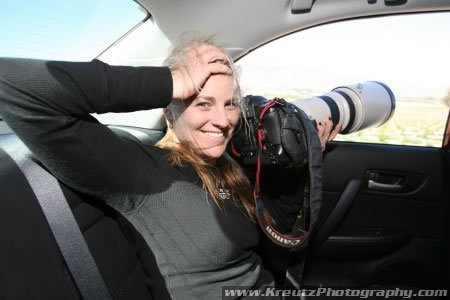
Liz, you create extraordinary art with your camera. Why photography?
Thank you so much! I have always loved to take photos, although when I was younger, I never analyzed it. I just loved capturing moments in time….of my family, friends, events….really anything. I could be counted on to always have a camera in hand.
It was not until college that I found my passion of photography in a photography elective class at the University of Texas. I went a little overboard on my projects!
Do you remember your first camera, how old were you?
I remember I got my first camera for Christmas when I was about five or six at my grandma’s house. It was an old point and shoot with the row of five flash bulbs that you stuck on the top for the flash. I thought it was so cool, but now it makes me laugh!
My first nice camera was my dad’s Canon 650. I LOVED that camera. It made beautiful prints and was easy to use. I “borrowed” it in high school and then declared it mine when I took my first class at UT.
 When did photography become a career option for you? Did you train at a school or learn on the job?
When did photography become a career option for you? Did you train at a school or learn on the job?
When I took my first photography class at UT the professor encouraged me to major in Photojournalism. I was almost a senior and in addition to a Major in Speech Communications, did not like the idea of more required classes, but decided to take the department head’s black and white class, where I learned how to develop and process film and print. I would spend hours in the dark room and that’s when I realized that photography was more than a fun hobby for me.
My professor recognized my love for photography and also my ability to personally connect with my subjects. He said one day I would combine my love of people and photographic eye to become a successful photographer. This is where I use my outgoing personality to my advantage.
Photography did not become my career until a few years later when I was dating my husband James and he encouraged me to start an event photography business. He is a professional triathlete and I photographed him and other athletes at races. Magazines purchased photos and started sending me on assignments.
At the same time my youngest brother, Nathan, was a high school quarterback and I photographed his games for fun. Parents of other players were interested in purchasing photos, so James built me an ecommerce website to sell my action photography. That eventually led to photographing bigger running and/triathlon events.
Which came first, sports or weddings? And what made you decide to specialise in sports photography?
Sports came first! I have always loved sports! I am the only girl on both sides of my extended family and have two very athletic brothers. We have always been involved in sports as long as I can remember. I wanted to combine my love of sports with my love of photography in a unique way, capturing the action and emotions of sports.
Instead of just the usual posed “team” photos I have from my years of playing various sports, I would much rather have action shots, as well as photos that show the emotion of the sport and relationships you have with your teammates. I felt there was a void here and wanted to focus on capturing the true spirit of sports.
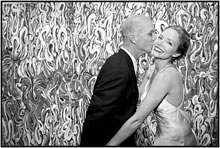 Not until a few years after I started my sports business did I decide to photograph a wedding (OK, I was begged and gave in). I wasn’t sure how I would feel about weddings, but I truly love them!
Not until a few years after I started my sports business did I decide to photograph a wedding (OK, I was begged and gave in). I wasn’t sure how I would feel about weddings, but I truly love them!
I only shoot a few a year, but I approach them like a sporting event. There is so much action going on that it is often like a three ring circus!
I also try to capture the emotion and tell the story of the day in a unique way. I can be very creative and again use my eye and personality to draw people out and get the memorable shots other photographers may not be able to. I strive to put the bride and groom at ease and be unobtrusive therefore achieving better photos … just like I try to do with the guys on the Discovery cycling team.
Who's your greatest creative influence, maybe a photographer or someone else?
I would have to say my parents. They have always supported and encouraged me to find and follow my passion. They are two of my biggest fans. After years of following the Tour de France on TV and through photos, it was fun for them to travel to the Tour de France to celebrate the finish in Paris this past summer. My dad loves the Tour and doesn’t even go into the office until the stage is over each morning. He keeps me up to date on the cycling news and emails me NY Times articles.
What photograph would you like to have taken?
I think back to when Lance had cancer. I wish I had taken a portrait of him during that time of his life. Life is about the journey … peeks and valleys and cancer has made Lance the man he is today. To look at him now, it is a miracle to see how far he has come and all that he has accomplished.
One of my favorite photos is of the two of us, ten years ago when he was going though chemo at a bike ride in Gruene, Texas. I framed it and gave it to him for his ten-year cancer free anniversary!
How did you get involved in Team Discovery?
Speaking of Lance, I knew Lance before he had cancer and later ended up working at the Lance Armstrong Foundation at its very beginning … proud employee number two! I worked and became friends with people at Capital Sports and Entertainment who manage the Discovery team. Last year, before the training camp in 2006, I got a call to photograph the Discovery team at their training camp to help produce the media guide and photos for the Paceline.com. The rest is history!

Credit : Cathy Mehl, thePaceline.com
You've taken some amazing photos of Discovery Channel. What do you think makes a great cycling photo?
So many things can contribute to a great cycling photo…I love the wow factor! Whether it’s the agony or joy on a rider’s face, the interaction between teammates, incredibly beautiful scenery, the massive pressing crowds or a lone fan, being in the right place at the right time, trying to anticipate what is going to happen…and, having the subject in the frame and in focus helps!
What photograph are you most proud of?
Hmmm…That’s a tough one. Probably the 2005 TT pre-race shot of Lance that I took of him as he warmed up near the team bus. I knew it was a cool shot as soon as I captured it. I like the image even better in Black and white. It’s a very unique shot which is why I like it so much.
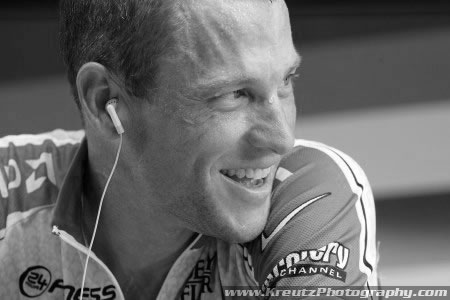
(Is this it? It's pretty fabulous in any case. See more)
When we look at your photos, they never fail to deliver a look within. Do you plan and analyze to achieve this? Or is it a more spontaneous approach?
Thanks for the compliment! I think when your subjects are comfortable with you; you are able to get more personal, natural shots. They let you into their circle in a way and you get a chance to document the moment … maybe an intimate one.
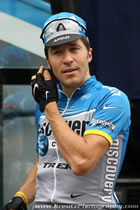 Most of the time the moments are spontaneous, but I will also assess the scene to see where I can achieve the unique shots. Sometimes the riders don’t even know I’m photographing them and when they do, they are relaxed.
Most of the time the moments are spontaneous, but I will also assess the scene to see where I can achieve the unique shots. Sometimes the riders don’t even know I’m photographing them and when they do, they are relaxed.
Of course, some riders love the camera more than others. Gusev and Billy are complete hams, while others are a little more camera shy so I have to work a little harder to get them to open up.
Chechu is wonderful to photograph. Not only is he handsome and super photogenic, but his kind genuine nature always shows through in the photos.
You took wonderful shots in mono at team camp in Solvang. How is working in black and white different to colour? Will you be doing more?
Sometimes when I am editing though the photos I think to myself, “Ooh, this shot would look awesome in black and white! Black and white photography is sometimes less distracting than color -- you see just the image. And in some cases, a BW image can evoke a very different feeling than a color photo.
Cycling is so beautiful in color because of the vast spectrum of colors in the sport, the team colors, the scenery, the festivities and fans, but sometimes the drama appears best in BW. So yes, I will be doing more!
Does traveling with the team make maintaining your studio at home a difficult balancing act?
Lucky for me I have a wonderful, supportive husband who is also my business partner. He manages the web, the technical side of things (thank goodness), while I focus on the photography. He has always supported my career and encourages me every step of the way. It wouldn’t work if I didn’t have his support. Besides, he loves watching the Tour on OLN (Versus) and holding down the fort in Austin. He’s a professional triathlete and just qualified for his 10th Ironman Hawaii in October, so he has a lot of miles to log on his bike this summer!
With Discovery Channel, you're a rare woman amongst mostly men. What's that like?
The Discovery Team truly is a family and I feel like the (younger/older) sister. I am honored to be able to travel and have exclusive access to the “behind the scenes” happenings. They trust me and know that I have their best interest at heart.
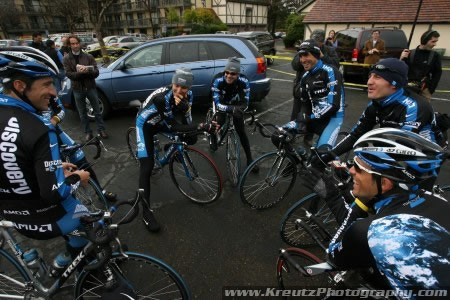 I also respect situations where the guys may not be in the mood to have their photo taken. I am sensitive to how the guys are feeling and know when to respect their privacy.
I also respect situations where the guys may not be in the mood to have their photo taken. I am sensitive to how the guys are feeling and know when to respect their privacy.
As a woman, I also feel that I can get a little more out of the guys in way of their personalities.
When we were photographing the team for the media guide last year in Solvang, I captured some great shots because everyone was in a terrific mood and I was joking with them, trying to make them feel as comfortable as possible…Sometimes, just a smile can put people at ease.
What’s it like shooting from the motorcycle? Scary? Thrilling?
Awesome! If you are going to cover the RACE, you really have to be on a moto. I am lucky enough to get a moto for one day during the Tour and it almost feels as if you are in a bubble.
You are so concentrated on your job, that you really don’t realize the real danger of some situations. Many of the moto drivers at the Tour de France not only are professional motorcycle drivers, but were also cyclists and know what lines the peloton is going to take, so they can anticipate when to pass safely and when to hang back.
When I photograph triathlons, I work with volunteer moto drivers and have to communicate with them on where to go, when to pass, etc., but during cycling races, the drivers are pros! They know how to do their job and that allows me to focus on the photography!
I had a moto driver this year for the Tour of Flanders and it was thrilling to say the least! I am usually a little dare-devil, but since this was his first race EVER and we weren’t actually IN the race, it was at times terrifying.
We were allowed to go ahead of the peloton onto the course and pick a place to pull over for a shot, but once the peloton passes us, we had to get off the course and use other routes to get ahead of the peloton. We did this, Oh about ten times…on highways splitting traffic (which is not legal in Texas)! Since he races motorcycles, he also leaned very close to the ground when he turned, so that was new for me, too. I swore we were going to fall over, but he reassured me that all was OK! Despite these “thrills”, I would choose to shoot from a moto over the car stop-n-go route any day!
At the races, do you decide the best locations for taking shots of the peloton? Or are you allocated positions? How do you decide where to go?
 I am fortunate to be able to photograph from a moto one day during the Tour de France.
I am fortunate to be able to photograph from a moto one day during the Tour de France.
The other days I am in my car and have access to the course, but I cannot pass the peloton at anytime.
So, I must choose what I want to do with my day. Usually during the early flat stages I get out on the course ahead of the peloton and pull over when I find a nice spot.
Then, as soon as the peloton passes, I follow them on the race route and get off the course as soon as possible to get ahead of them again by a side route.
I try and map out alternate routes the night before so I might have two or three chances to photograph the peloton on the route before hurrying to the finish the get in position at the finish line to shoot the final sprint. This is where having a driver comes in handy!
When the stage has a mountain top finish and no side routes, I usually only get one shot at the riders, so I have to choose between photographing somewhere along the course or at the finish. I usually pick somewhere close to the top where the last minute drama will hopefully unfold.
What have you learned from working with cycling’s great photographers, like Graham Watson? How has your work different from colleagues like Graham or Roberto Bettini?
Graham is not only one of the best cycling photographers in the world with a vast knowledge of the sport (he used to be a rider back in the day!), but he is also a wonderful person. He has a great sense of humor and is always willing to offer help and suggestions.
I have always admired Graham’s work, but I respect him more now that I have gotten to know him. He is very professional and treats everyone with respect. I do not know Roberto as well, but he is also one of the best.
Graham and Roberto do a fantastic job of covering the “race” aspect of the races, so I try to photograph the races from a different angle, showing more “behind the scenes” moments and capturing the riders’ personalities.
Of course I also love to shoot the race, but it’s difficult when you aren’t on a moto every day and may only have one shot opportunity each day. There is a lot more to the world of cycling and the aspect of the community than the actual race. I want fans to feel as if they are there experiencing the race when they look through my photos!
Do you know which races you’ll work in 2007? Can you let us know where to look for you?
I am excited to photograph Chechu at the Giro d’Italia. I’ll be sure to get extra shots of him next week just for you guys!
What’s your favorite race?
My favorite race is the Tour de France and then the Classics … two completely different experiences but so much history and drama … the TDF in three weeks the Classics in a day. I also love the Giro because it’s more laid back than the Tour and the food is AMAZING!!! I can’t wait for the risotto!
What five words best describe Chechu Rubiera?
The Chechu I know is kind, thoughtful, positive, consistent and photogenic!!
And finally, a few secrets about yourself ...
A book that changed me ...
This Voice in My Heart : A Genocide Survivor’s Story of Escape, Faith and Forgiveness
The best invention ever ...
The Camera of course!
When I was a child, I wanted to be ...
An astronaut
My favourite word ...
Hello
If I had time to myself, I would …
I wouldn’t know what to do.
You may not know it, but I'm very good at ...
Karaoke
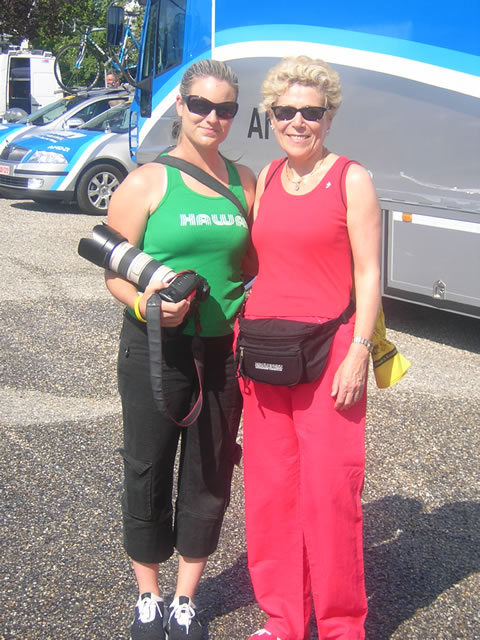 Liz with our own Christine Kahane at the Tour 2006
Liz with our own Christine Kahane at the Tour 2006
Photo Credits: Masthead: Liz Kreutz, 2007. Left column from top: Liz Kreutz. Right column from top: Liz Kreutz (mostly), Cathy Mehl, Roger Kahane